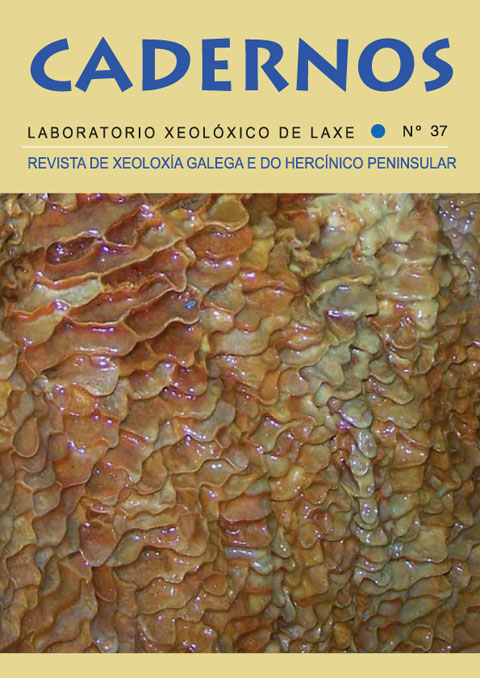Development trends of tafoni forms (incipient stages)
Contido principal do artigo
Resumo
Forms called tafoni, diversified in different stages, are complex natural systems. The systematic register of their measurements is performed in order to infer relative ages and to use the results to reconstruct landscape evolution. The analysis of depth measures of the cavities developed into several tafoni demonstrates, for incipient cases in Galicia (NW of Iberian Peninsula), trends with different evolutionary trajectories. Depth measures were processed with robust statistical techniques. The development of tafoni combines linear and non-linear phases. This behaviour is related to the increase of complexity through self-organisation.
Palabras clave:
Descargas
Detalles do artigo
Citas
De Uña Álvarez, E. (2004). Tafoni en rocas graníticas. Primera valoración estadística sobre tasas de desarrollo en el macizo de Ourense (Galicia, NW de la península ibérica). Cadernos do Laboratorio Xeolóxico de Laxe, 29, 265-289.
De Uña Álvarez, E., Vidal Romaní, J. R. (2006). Estructura y forma: estudio experimental en cacholas (tafoni) de galicia (NW Peninsular). Geomorfología y Territorio - IX Reunión Nacional de Geomorfología, Serie Cursos y Congresos USC, 171, 785-793.
De Uña Álvarez, E., Vidal Romaní, J. R. (2008). Some minor features (tafoni, cavernous forms) in the granite terrains of Los Riojanos (Pampa de Achala, Sierra Grande de Córdoba, República Argentina). Geometric and morphologic properties. Cadernos do Laboratorio Xeolóxico de Laxe, 33, 83-100.
Twidale, C. R., Vidal Romaní, J. R. (2005). Landforms and Geology of Granite Terrains. London, Balkema, 351 p.
Twidale, C. R., Bourne, J. A. (2008). Caves in granitic rocks: types, terminology and origin. Cadernos do Laboratorio Xeolóxico de Laxe, 33, 35-57.



